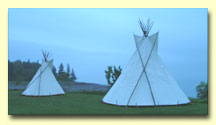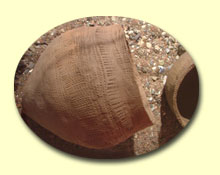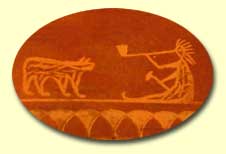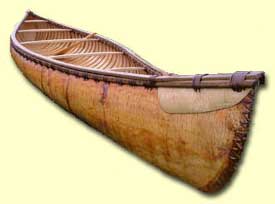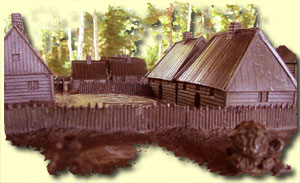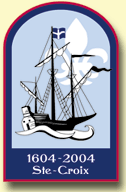 |
 |
Passamaquoddy Tribal History in the St. Croix Estuary
|
||
|
|
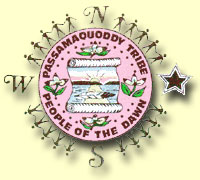 |
|
|
The Passamaquoddy Meet the French June 1604In late June of 1604, Pierre Dugua Sieur de Mons sailed into the Passamaquoddy Bay as far as the Passamaquoddy village of Quonasquamcook, present day St. Andrews, New Brunswick, Canada.
Upon further examination however, they could see human beings walking on the deck of Dugua's ship. Chief Esauqueet immediately prepared for war. He selected three canoes and with the bravest of his warriors, paddled out toward the ship. The captain of the ship invited them aboard by motions of his hands. They went and were used well. This would be the first time alcohol was given to the tribe. The captain made a toast to the health of the King of France and as Dugua and Chief Esauqueet raised their glasses, a big cannon on the ship fired three times. The Passamaquoddy people who were watching from the shore jumped into their canoes and made ready for war. When the crew of the ship saw what was happening, they notified Chief Esauqueet and the chief knew at once what they meant. He stood on the rail of the ship and called out "Mena gotch kole ya gap" meaning "Be easy, we are all right". Relations were good so Pierre Dugua ordered ashore three boatloads of tools, axes, knives, cooking utensils and vegetable seeds. Pierre Dugua had with him a Roman Catholic missionary and at that time so Chief Esauqueet and many of his people were introduced to Christianity. The word "Esauqueet" means, "His power penetrates the big trees". At that time, the title of Chief was held for life and was handed down through the family. The Esauqueet family held the title for many years. When Esauqueet died the title of Chief went to one of that family, Agoumett. Later, Agoumett was cruelly murdered after being decoyed into the Fort at Pemaquid, Maine. The next Chief still from the same family was Bah Gidwett whose Christian name was Jean Baptiste Neptune. His successors were Francis Joseph Neptune, John Francis Neptune, Lewy Francis Neptune, Solomon Francis Neptune, Newell Francis Neptune, Sabattus Joseph Neptune and William Neptune . |
|||||||||||||||||||||||||||||
|
The first inhabitants of what is now known as the Quoddy area were the Passamaquoddy People who lived in small, mobile groups and gathered and hunted in a land that had only recently been freed from the grip of a massive continental ice sheet. Archeologists call this period the Paleo-Indian phrase. Sites of these original pioneers have been found at several locations in Maine and New Brunswick. The fluted points characteristic of Passamaquoddy hunter-gatherers have been found in the vicinity of Calais/ St. Stephens and in the upper part of the St. Croix River drainage, near West Grand Lake. During the next several millennia, the environment of the Quoddy area, and of the Northeast in general, changed and became more similar to that of the present. During his period, known as the Archaic, Passamaquoddy people developed patterns of subsistence and settlement some of which persisted into the 17th century. The Archaic period witnessed the growth of Passamaquoddy populations, and the development and florescence of several cultural traditions. The period provides archeological evidence of an increase in the expression of ritual, particularly in the burial of the dead, and the earliest evidence of the use of marine resources in the Passamaquoddy Bay region.
Quoddy tradition sites typically are located near the waters edge and contain a midden area near the water with a habitation area further back from the beach. The dwellings appear to be single-family wigwams built over shallow depressions. Many shell middens date from this period. They bear evidence of an economy strongly oriented toward the sea, at least seasonally. The northeast coast of North America was well known in the seaports of France, Spain the Basque country, Portugal, and west Country England long before the founding of the colony of Acadia in New France. By the end of the 15th century, Europeans were beginning to visit the rich fishing waters of the Grand Banks; fisherman probably landed along the shores of Gulf of Maine, establishing contact between Europeans and Native Americans. John Cabot, sailing for England, may have reached the coast of present-day Maine in 1498. Gasper and Miguel Corte Real explored the coast of what is today Newfoundland and may have reached Maine in about 1500.
The Quoddy Area (16th century) At the beginning of the 16th century, the St. Croix valley was the center of the homeland of the Passamaquoddy people. The Passamaquoddies, were also called the Etchemins by the earlier French explorers, the tribal people speak a Algonquian language with a Wabanaki dialect very similar to that spoken by the Maliseet, whose homeland includes the St. John River Valley. At the time of first contact with Europeans, the Passamaquoddies were living in summer village in and around Passamaquoddy Bay. They subsisted by hunting and gathering, focusing particularly on the marine and estuarine resources of the St. Croix River, Passamaquoddy Bay, and the Bay of Fundy, as well as the resources of the interior forests in the upper St. Croix watershed. Several Passamaquoddy names for places in the St. Croix River estuary have been recorded. These include Schoodic for the St. Croix River, Mak wam kusk for Red Beach, and Muttoneguis, Muttoneguamus, Metanegwis, Metnegwis for St. Croix Island. Contact between the local Native peoples and European fishermen and explorers certainly began during the 16th century, if not earlier. The Native communities of the St. Croix River valley had at least indirect contact with Basque, Portuguese and English ships and their crews; however, none had ever-established year-round settlements. These ships were mostly fishing boats drawn to the rich fishing grounds off the coast of northeastern North America. Europeans made several documented explorations of the region. Verrezano, sailing for France in 1554, visited Passamaquoddy in what is now Maine, who already was acquainted with the fur trade. The following year, Estavan Gomaz, sailing for Spain, explored the Penobscot River. Later, French and English ships explored the Penobscot, and the two nations began trading and competing on the coast of present-day Maine and points east.
The effects of the fur trade on Native societies were far-reaching and continued to be important for many years after the century's end. New materials altered traditional technology, personal adornment, and ritual. Subsistence focused increasingly on furbearers, especially beaver, often at the expense of important food animals, with the result that local fur-bearer populations were over hunted and depleted. Cycles of labor altered to allow for more time spent processing furs for market. Political systems were thrown out of balance by increasing competition between groups for trapping grounds and access to traders. Finally, increased contact with Europeans brought diseases to which Native Americans had no immunities. These virgin soil epidemics devastated Native populations during the early years of the 17th century. By the end of the 16th century, France and England had made several explorations in advance of colonization, and had established a few seasonal settlements for trading and fishing along the north Atlantic coast. A group of French convicts and beggars was landed at Sable Island in 1598, and remained until 1603. The French built a trading post at Tadoussac on the lower St. Lawrence River in 1599.
St.Croix Island (16th century) The name Muttoneguis (variously written) given to the island by the Passamaquoddy people, suggests possible ways they may have used it. Among several possible translations, it signifies a place to store things. One Passamaquoddy informant in 1796 explained that they left food stores there where they would be safe from animals. Aside from this sort of temporary use by the Passamaquoddies, there is no record of activity here. Certainly, the Passamaquoddies must have visited the island on occasion since it is located within the heart of their traditional homeland. Seventeenth Century
The Passamaquoddies continued to occupy the area throughout the 17th century. Champlain and Lescarbot referred to them as the Etchemins, and called the St.Croix River the River of the Etchemins. The name Passamaquoddy first appears in 1692. By 1711, the Passamaquoddy population had fallen below 1,000 as a result of European diseases. Their position in the regional geopolitics had also changed as the Mikmaq people, with the support of the French, began to dominate the regions Native groups, Passamaquoddy allied with the MikMiq. The French also brought Jesuit missionaries, to convert Passsamaquoddies to the Catholic religion. Following up on the explorations and visits of the previous century, the governments of England and France began efforts to establish permanent settlements and secure territories and trading monopolies on the coast of northeastern North America. Their goal, as stated by Champlain, was to find a route to China by the north, in order to facilitate commerce with the peoples of East Europe. Government monopolies on fur trading would be granted to individuals or groups of investors in return for their efforts to establish permanent settlements in the region. |
|||||||||||||||||||||||||||||
There are two theories regarding the origin of the name "Acadia". The first credits the explorer Verrazano who, in 1524, named the coastline of the present-day Middle Atlantic States Arcadia, romantically evoking the beauty and innocence celebrated in classical Greek poetry. The second and possibly more plausible theory is that Arcadie derives from a Mi'kmaq word rendered in French as cadie, meaning a piece of land, generally with a favorable connotation. The word -cadie is found in many present-day place names such as Tracadie and Shubenacadie in the Canadian Maritimes, and Passamaquoddy, an English corruption of Passamacadie. |
|||||||||||||||||||||||||||||
|
St. Croix Island (17th century) The search for a suitable site for the settlement was delayed by having first to enforce Sieurs de Mons' trade monoply, then to explore the coastline. After many stops, the company arrived in Passamaquoddy Bay in late June. The men explored a river whose tributaries appeared to join in the shape of a cross. Sieur de Mons named the island below the confluence Ile-Sainte-Croix, and chose to establish a habitation upon it because of its good anchorage, defensibility, and central location in Acadia. Champlain left a remarkable record of the 1604-05 settlement. He described the different groups of the Native Americans encountered during their voyages, as well as the challenges of sowing grain and nurturing gardens over a dry summer As the settlers built their village, members of the Passamaquoddy communities visited them. Relations appear to have been amicable, and several Tribal parties made tempory camp on the island, and assisted the colonists in various endeavors.
The settlers were never attacked; no European rivals appeared and relations with the Tribal peoples were peaceful. The biggest danger was the island's exposed location and the winter weather. Mild weather brought relief from the harsh conditions, and Passamaquoddy people arrived with fresh game. In mid-June a supply vessel arrived from France. Sieur de Mons resolved to relocate his colony to a more favorable setting. The settlers dismantled the structures they had built, with the exception of the storehouse, loaded all the timbers onto the ship, and left the island. Three of the St. Croix Island survivors, including Champlain, joined new recruits to cross the great bay to an area Champlain had named Port Royal during the explorations the previous year. The lessons learned at St. Croix Island were put to good use, and a more promising foothold for fledging colony resulted.
To learn more about the Passamaquoddy People visit the Tribal web site at www.wabanaki.com.
|
|||||||||||||||||||||||||||||
|
|||||||||||||||||||||||||||||
